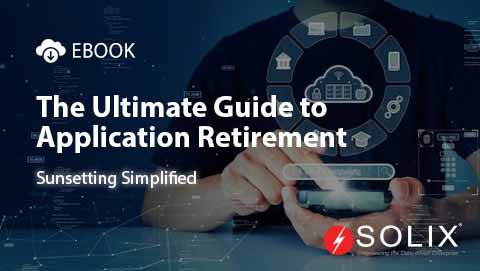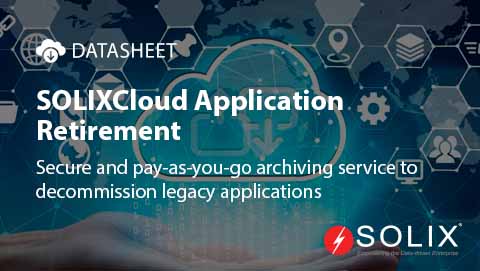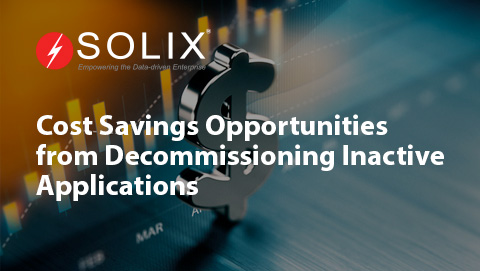
Guide for Application Retirement
If youre in the world of IT or software management, you may find yourself asking, What is the best way to handle application retirement This question is crucial as retiring an application isnt just a matter of turning it off; it involves a strategic plan that ensures smooth transitions while minimizing disruptions. In this guide for application retirement, Ill walk you through the process, share lessons learned from practical experiences, and explain how Solix can ease your applications end-of-life journey.
Imagine this youre part of a tech team at a growing company. Youve just completed a successful implementation of a shiny new software system, but theres that old application lingering in the shadows. Its becoming outdated, posing security risks, and requiring more resources than its worth. How do you safely retire it Lets dive into the phases of application retirement that can make this transition as seamless as possible.
Understanding the Importance of Application Retirement
Application retirement is not merely a technical task; its an essential part of your organizations lifecycle management. Retiring applications can free up resources, reduce costs, and improve security posture by removing outdated or vulnerable software. However, it requires careful planning and execution to ensure that critical data doesnt get lost and that user access is appropriately transitioned.
Step-by-Step Guide for Application Retirement
First, lets break down the necessary steps for a successful application retirement
1. Assessment Before taking any action, assess the application in question. Is it meeting the current needs of your organization What are the potential risks of keeping it active Collaborate with stakeholders to gather insights and ensure everyone is on the same page.
2. Documentation Maintain thorough documentation of the applications functionalities and the data it processes. This documentation will be invaluable when sitting down for a data retirement review or when transferring essential data to new systems.
3. Data Migration Identify what data needs to be retained, migrated, or archived. This part is particularly sensitiveensure that you dont lose vital information that can affect ongoing operations.
4. Communication Keeping your team and users informed is crucial. Make sure everyone knows the timeline and what to expect. This transparency can help prepare users for the upcoming changes and avoid unnecessary stress.
5. Decommissioning Finally, once everything is documented and data is migrated, you can safely decommission the application. This process should include safe disposal of hardware involved and ensuring that any remaining data is permanently deleted where necessary.
Real-World Insights from the Field
In my experience, the most challenging part of the guide for application retirement isnt the technical steps but the people involved. For instance, a colleague of mine shared a story about retiring an old CRM system that had been in use for over a decade. The users were emotionally attached to the old system, believing it to be integral to their workflow. The transition to a new system was rocky, highlighting the need for targeted training and support. Investing time in training was essential, helping users adapt to the change and leading to a successful retirement of the older application.
Lessons Learned
From this story and others like it, Ive learned a few key lessons that can help anyone about to embark on a guide for application retirement
- Engage Stakeholders Early Involve the right people from the beginning to foster collaboration.
- Prioritize Training Ensure that training aligns with the new systems functionalities.
- Be Prepared for Resistance Change can be hard. Address concerns and provide support as needed.
To ensure a smoother process, leveraging a solution like Solix Enterprise Data Archiving can greatly simplify the data management aspect of application retirement. With their solutions, you can achieve an organized and compliant method of handling data migration and archiving securely, further enhancing the overall retirement process.
The Role of Solix in Application Retirement
When considering a guide for application retirement, Solix steps in as a valuable partner. Their platforms not only assist in data management but also bring in expertise in regulatory compliance, archiving, and policy-driven data governance. This assists organizations in minimizing risk and ensuring that critical operations arent disrupted during the transition.
If you need personalized guidance on how to manage your application retirement processes, I recommend reaching out to Solix directly. Their team can provide tailored advice suited to your organizations unique needs
Call 1.888.GO.SOLIX (1-888-467-6549)
Contact https://www.solix.com/company/contact-us/
Wrap-Up
The journey of application retirement can seem daunting, but with a well-structured guide and strategic support, it can be a rewarding process that not only clears the path for new innovations but bolsters your security and efficiency. Embrace the steps with a solid plan, engage your team, and dont hesitate to leverage solutions offered by experts in the field, like Solix. With their support, your organization can navigate this transition with confidence.
About the Author
Hi, Im Jake. Ive spent years in the tech industry, grappling with the various challenges of application lifecycle management, including the intricate guide for application retirement. My goal is to share insights that can help others navigate these waters with ease and assurance.
Disclaimer
The views expressed in this blog are my own and do not necessarily reflect the official position of Solix.
Sign up now on the right for a chance to WIN $100 today! Our giveaway ends soon‚ dont miss out! Limited time offer! Enter on right to claim your $100 reward before its too late!
DISCLAIMER: THE CONTENT, VIEWS, AND OPINIONS EXPRESSED IN THIS BLOG ARE SOLELY THOSE OF THE AUTHOR(S) AND DO NOT REFLECT THE OFFICIAL POLICY OR POSITION OF SOLIX TECHNOLOGIES, INC., ITS AFFILIATES, OR PARTNERS. THIS BLOG IS OPERATED INDEPENDENTLY AND IS NOT REVIEWED OR ENDORSED BY SOLIX TECHNOLOGIES, INC. IN AN OFFICIAL CAPACITY. ALL THIRD-PARTY TRADEMARKS, LOGOS, AND COPYRIGHTED MATERIALS REFERENCED HEREIN ARE THE PROPERTY OF THEIR RESPECTIVE OWNERS. ANY USE IS STRICTLY FOR IDENTIFICATION, COMMENTARY, OR EDUCATIONAL PURPOSES UNDER THE DOCTRINE OF FAIR USE (U.S. COPYRIGHT ACT § 107 AND INTERNATIONAL EQUIVALENTS). NO SPONSORSHIP, ENDORSEMENT, OR AFFILIATION WITH SOLIX TECHNOLOGIES, INC. IS IMPLIED. CONTENT IS PROVIDED "AS-IS" WITHOUT WARRANTIES OF ACCURACY, COMPLETENESS, OR FITNESS FOR ANY PURPOSE. SOLIX TECHNOLOGIES, INC. DISCLAIMS ALL LIABILITY FOR ACTIONS TAKEN BASED ON THIS MATERIAL. READERS ASSUME FULL RESPONSIBILITY FOR THEIR USE OF THIS INFORMATION. SOLIX RESPECTS INTELLECTUAL PROPERTY RIGHTS. TO SUBMIT A DMCA TAKEDOWN REQUEST, EMAIL INFO@SOLIX.COM WITH: (1) IDENTIFICATION OF THE WORK, (2) THE INFRINGING MATERIAL’S URL, (3) YOUR CONTACT DETAILS, AND (4) A STATEMENT OF GOOD FAITH. VALID CLAIMS WILL RECEIVE PROMPT ATTENTION. BY ACCESSING THIS BLOG, YOU AGREE TO THIS DISCLAIMER AND OUR TERMS OF USE. THIS AGREEMENT IS GOVERNED BY THE LAWS OF CALIFORNIA.
-
-
-
White Paper
Cost Savings Opportunities from Decommissioning Inactive Applications
Download White Paper -




